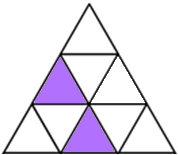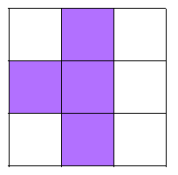Copyright © University of Cambridge. All rights reserved.
'Shady Symmetry' printed from https://nrich.maths.org/
Show menu
Why do this problem?
This problem provides an engaging challenge that requires students to work systematically at producing various symmetrical patterns. There are a variety of avenues for exploration and extension work, and learners' results can be used to brighten up the classroom walls.
Possible approach
These printable resources may be useful: Shady Symmetry problem,
Shady Symmetry images,
Shady Symmetry Isometric Template,
Start by displaying the two patterns from the problem for everyone to see - they are available on this PowerPoint Slide.


Ask students to discuss the two images in pairs, focusing on what they notice about the two pictures, what is the same and what is different. Then bring the class together to share their ideas.
Explain that the challenge will be to explore symmetrical patterns drawn on grids of triangles or squares, and give students a little longer with their partners to come up with some lines of enquiry to explore. Collect their ideas together on the board (some suggestions are made in the problem if more ideas are needed).
Then allow pairs or small groups to choose one of the ideas to work on, and hand out some of these square and triangular grids. Make the class aware that at the end of the time spent on this (it could be more than one lesson) they will be expected to display their work in a way that will convince
others that they have considered every possible symmetrical pattern for their chosen question. While students are working on the task, you might use mini-plenaries to encourage students to share their thinking and to draw attention to those who are working in a systematic way.
Key questions
- What different types of symmetry do the initial grids exhibit?
- If you colour a triangle or square here, what else must be coloured in to keep it symmetrical?
- What are the possible symmetries of a finished pattern?
- How can you be sure you have found all the symmetric patterns?
Possible support
Encourage students to begin by looking at all the patterns that can be made by colouring in just 1 cell, then 2, then 3, and so on...
Offer tracing paper to those who might find it helpful.
Encourage students to number the cells of their grids to help them list shadings in a systematic way.
Draw a big table on the board with
column headings: 0, 1, 2, 3, more lines of symmetry,
row headings: order 1, 2, 3, more for rotational symmetry.
Fill in "not symmetrical" in the top left cell (0 lines of symmetry and rotational symmetry of order 1), and then ask students to suggest examples that could go in each of the other cells of the table.
Possible extension
The problem can be extended to be done on these 4 by 4 square and triangular grids, and of course there are opportunities to extend into three dimensions...